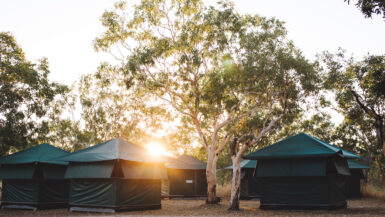Camping is a popular recreational activity that brings people closer to nature, away from the hustle and bustle of daily life. However, camping can also have negative impacts on the environment if not done sustainably. With the increasing concern for the environment, it is important to adopt sustainable camping practices to minimize our impact on the environment. In this article, we will discuss various sustainable camping practices that can help preserve the natural beauty of our camping destinations and ensure that future generations can also enjoy them.
Choosing Eco-Friendly Camping Gear
Camping is a great way to reconnect with nature and escape from the hustle and bustle of everyday life. However, it’s important to be mindful of the impact we have on the environment while enjoying the great outdoors. One way to reduce our impact is by choosing eco-friendly camping gear.
When selecting camping gear, look for products made from sustainable materials such as bamboo, hemp, or recycled materials. These materials are renewable, biodegradable, and have a lower impact on the environment than traditional camping gear made from synthetic materials.
Additionally, consider the longevity of the product. Investing in high-quality gear that will last for years to come reduces waste and the need to constantly replace gear. Look for gear with a repairable or replaceable parts option to further extend the life of your gear.
Another consideration is the packaging of the products. Avoid items with excessive packaging or packaging that cannot be recycled. Look for products with minimal packaging or packaging made from recycled materials.
By choosing eco-friendly camping gear, we can reduce our impact on the environment while enjoying the great outdoors.
Leave No Trace Principles for Camping
When camping, it’s important to follow the Leave No Trace principles to minimize our impact on the environment. These principles are simple guidelines that help us enjoy the outdoors while preserving it for future generations.
The first principle is to plan ahead and prepare. This means researching the camping area and understanding the rules and regulations. It also means packing appropriately and bringing only what is necessary to minimize waste and reduce our impact on the environment.
The second principle is to camp and travel on durable surfaces. This means sticking to established campsites and trails to avoid damaging fragile ecosystems. It’s important to avoid trampling on vegetation and disturbing wildlife habitats.
The third principle is to dispose of waste properly. This means packing out all trash and leaving the campsite in better condition than we found it. It’s important to properly dispose of human waste using designated facilities or by burying it in a shallow hole at least 200 feet from water sources.
The fourth principle is to leave what we find. This means not disturbing natural or cultural features such as rocks, plants, and artifacts. It’s important to respect the environment and leave it as we found it.
The fifth principle is to minimize campfire impact. This means using established fire rings or fire pans and avoiding building new fire rings. It’s important to use only dead and downed wood for fires and to fully extinguish fires before leaving the campsite.
The sixth principle is to respect wildlife. This means observing wildlife from a distance and not approaching or feeding them. It’s important to avoid disturbing their natural behaviors and habitats.
By following the Leave No Trace principles, we can enjoy camping while preserving the environment for future generations.
Sustainable Food Choices for Camping Trips
Food is an essential part of any camping trip, but it’s important to choose sustainable options to reduce our impact on the environment. Here are some tips for making sustainable food choices while camping:
Choose Local and Organic
When shopping for food, choose locally sourced and organic options whenever possible. This reduces the environmental impact of transportation and supports local farmers. Additionally, organic food is grown without harmful pesticides and chemicals, which is better for both our health and the environment.
Minimize Packaging Waste
Packaging waste is a significant contributor to environmental pollution. To minimize packaging waste, choose foods that come in reusable or recyclable packaging. Alternatively, consider buying in bulk and bringing your own reusable containers to store food.
Reduce Meat Consumption
The production of meat has a significant impact on the environment, including greenhouse gas emissions and deforestation. Consider reducing your meat consumption while camping and opting for vegetarian or vegan options instead. Not only is this better for the environment, but it can also be a healthier option.
Proper Food Storage and Disposal
Proper food storage and disposal is important to prevent attracting wildlife and leaving a mess at the campsite. Store food in airtight containers and keep them away from sleeping areas to avoid attracting animals. When disposing of food waste, follow the Leave No Trace principles and pack out all trash or properly dispose of it in designated facilities.
By making sustainable food choices while camping, we can reduce our impact on the environment and enjoy delicious meals in the great outdoors.
How to Properly Dispose of Waste While Camping
Proper waste disposal is a critical part of sustainable camping practices. Improper disposal of waste can lead to pollution, harm wildlife, and damage the environment. Here are some tips for proper waste disposal while camping:
Pack It In, Pack It Out
The golden rule of camping waste disposal is to pack out all trash. This means bringing a trash bag and packing out all waste, including food scraps, toilet paper, and hygiene products. Do not leave any trash behind, even if it’s biodegradable.
Human Waste Disposal
Human waste should be disposed of properly to prevent contamination of water sources and the spread of disease. If there are no designated facilities, dig a small hole at least 200 feet from water sources and bury human waste. Use biodegradable toilet paper and pack it out with your trash.
Greywater Disposal
Greywater is wastewater from washing dishes and personal hygiene. It should be disposed of properly to prevent contamination of water sources. Strain out any food particles and scatter greywater at least 200 feet from water sources. Do not use soap or other cleaning products directly in water sources.
Recycling
If there are recycling facilities available, make use of them. Separate recyclable items from trash and pack them out. If there are no recycling facilities available, pack out all recyclable items and dispose of them properly at home.
By properly disposing of waste while camping, we can minimize our impact on the environment and preserve the beauty of the outdoors for future generations to enjoy.
The Benefits of Using Renewable Energy Sources While Camping
Camping provides an opportunity to disconnect from modern technology and reconnect with nature. However, that doesn’t mean we can’t use sustainable technology to power our camping trips. Here are some benefits of using renewable energy sources while camping:
Reduced Carbon Footprint
Using renewable energy sources such as solar or wind power can significantly reduce our carbon footprint while camping. Traditional energy sources such as gasoline or propane emit greenhouse gases that contribute to climate change. By using renewable energy sources, we can reduce our impact on the environment and preserve the natural beauty of the outdoors.
Cost-effective
While the initial investment in renewable energy sources may be higher, in the long run, it can be cost-effective. Solar panels and wind turbines require little to no maintenance and provide a free source of energy. This reduces the need to purchase expensive and polluting traditional energy sources.
Quiet and Non-intrusive
Renewable energy sources such as solar panels and wind turbines are quiet and non-intrusive, allowing us to enjoy the peacefulness of nature without the noise and pollution of traditional energy sources.
Independence from Grid Energy
Using renewable energy sources allows us to be independent from grid energy, providing a sense of self-sufficiency and reducing our reliance on traditional energy sources.
By using renewable energy sources while camping, we can reduce our impact on the environment, save money, and enjoy the peacefulness of nature without the noise and pollution of traditional energy sources.
The Impact of Campfires on the Environment and Alternatives to Traditional Fires
Campfires are a traditional part of camping, but they can have a significant impact on the environment. Here are some of the environmental impacts of campfires and alternatives to traditional fires:
Impact on Air Quality
Campfires emit smoke and particulate matter, which can have a negative impact on air quality. This can be especially harmful to people with respiratory problems or allergies. Additionally, the smoke and particulate matter contribute to air pollution and climate change.
Impact on Soil Quality
Campfires damage the soil by removing organic matter and nutrients from the soil. This can lead to soil erosion and reduce the ability of plants to grow in the area.
Impact on Wildlife
Campfires can disturb wildlife by destroying habitats and food sources. Additionally, the smell of food and smoke can attract animals to the campsite, putting both humans and animals at risk.
Alternatives to Traditional Fires
There are several alternatives to traditional fires that are better for the environment. One option is to use a portable stove or grill that uses propane, butane, or other clean-burning fuels. Another option is to use a camping stove that uses renewable energy sources such as solar or wind power. These alternatives are safer, cleaner, and more sustainable than traditional fires.
If you do choose to have a campfire, follow the Leave No Trace principles and use established fire rings or fire pans. Only use dead and downed wood for fires and fully extinguish fires before leaving the campsite.
By using alternatives to traditional fires and being mindful of the impact of campfires, we can enjoy camping while preserving the environment for future generations.
The Importance of Respecting Wildlife and Their Habitats While Camping
Camping provides an opportunity to observe wildlife and their habitats up close. However, it’s important to respect wildlife and their habitats to minimize our impact on the environment. Here are some tips for respecting wildlife and their habitats while camping:
Observe from a Distance
Observing wildlife from a distance is important to avoid disturbing their natural behaviors and habitats. Do not approach or feed wildlife, and avoid taking flash photographs or making loud noises that can startle or scare animals.
Protect Wildlife Habitats
Protecting wildlife habitats is important to maintain biodiversity and the natural balance of ecosystems. Avoid trampling on vegetation, disturbing soil, or damaging habitats. Stay on established trails and campsites to avoid damaging fragile ecosystems.
Store Food Properly
Storing food properly is important to prevent attracting wildlife to the campsite. Store food in airtight containers and keep them away from sleeping areas to avoid attracting animals. Never leave food unattended or dispose of food waste improperly.
Dispose of Waste Properly
Proper waste disposal is important to prevent attracting wildlife to the campsite and contaminating water sources. Follow the Leave No Trace principles and pack out all trash or properly dispose of it in designated facilities. Use designated facilities or bury human waste at least 200 feet from water sources.
By respecting wildlife and their habitats while camping, we can minimize our impact on the environment and preserve the natural beauty of the outdoors for future generations to enjoy.
How to Minimize Your Carbon Footprint While Camping
Camping is an excellent way to connect with nature, but it’s important to minimize your environmental impact as much as possible. One way to do this is by reducing your carbon footprint. Here are some tips to help you minimize your carbon footprint while camping.
Use Reusable Items
Disposable items like paper plates, plastic cups, and utensils contribute to waste and pollution. Instead, use reusable items like plates, cups, and utensils made from materials like bamboo or stainless steel. This will not only reduce your waste but also save you money in the long run.
Choose Sustainable Transportation
Driving to your camping destination can contribute significantly to your carbon footprint. Consider using public transportation or carpooling to reduce your emissions. If you must drive, make sure your vehicle is well-maintained, and avoid idling.
Reduce Energy Consumption
When camping, it’s essential to conserve energy. Use energy-efficient lighting and appliances, and turn them off when not in use. Also, consider using renewable energy sources like solar panels or wind turbines to power your devices.
Be Mindful of Your Food Choices
Food production and transportation contribute to greenhouse gas emissions. Choose food items that are locally produced and in season. Also, consider reducing your meat consumption, as meat production has a significant environmental impact.
Minimize Your Waste
Properly disposing of your waste is crucial to minimizing your environmental impact. Pack out all your trash and recyclables, and dispose of them properly. Also, avoid using single-use items like plastic bags and water bottles.
By following these tips, you can significantly reduce your carbon footprint while camping. Remember, every little bit helps, and we all have a responsibility to protect the environment for future generations.
The Benefits of Using Public Transportation or Carpooling to Get to Your Camping Destination
Traveling to your camping destination can have a significant impact on the environment. However, there are ways to reduce your carbon footprint and minimize your impact. One way to do this is by using public transportation or carpooling.
Using Public Transportation
Using public transportation to get to your camping destination is an excellent way to reduce your carbon footprint. Many campgrounds are accessible by public transportation, such as buses or trains. By using public transportation, you can reduce your emissions and also save money on gas and parking fees.
Carpooling
Carpooling is another great option to reduce your environmental impact while traveling to your camping destination. By sharing a ride with others, you can reduce the number of vehicles on the road and, as a result, reduce emissions. Carpooling is also an excellent way to save money on gas and parking fees.
The Benefits of Using Public Transportation or Carpooling
In addition to reducing your carbon footprint, using public transportation or carpooling has many other benefits. For example, it can reduce traffic congestion, which can save you time and reduce stress. It can also be a great way to meet new people and make new friends who share your love for the outdoors.
Overall, using public transportation or carpooling is an excellent way to reduce your environmental impact while traveling to your camping destination. Not only does it reduce your carbon footprint, but it also has many other benefits. So, before you hit the road on your next camping trip, consider using public transportation or carpooling to minimize your impact on the environment.





Leave a reply